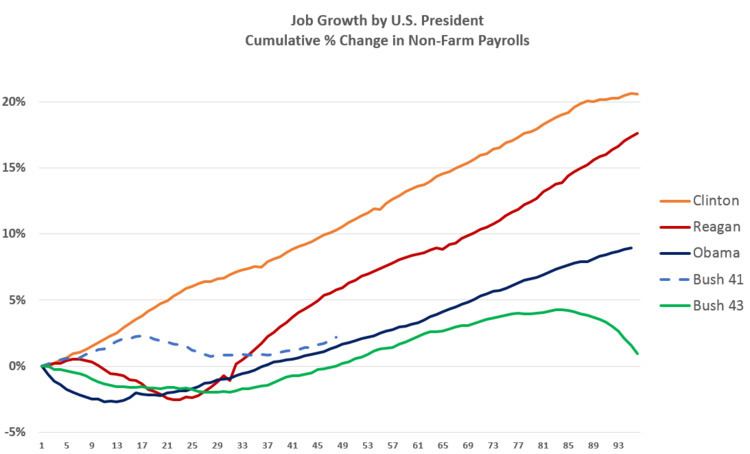 | ||
Politicians and pundits frequently refer to the ability of the President of the United States to "create jobs" in the U.S. during his or her term in office. The numbers are most often seen during the election season or in regard to a President's economic legacy. The numbers typically used and most frequently cited by economists are total nonfarm payroll employment numbers as collected by the Bureau of Labor Statistics on a monthly and annual basis. The BLS also provides numbers for private-sector non-farm employment and other subsets of the aggregate that are more useful for making points.
Contents
Methodology
The job numbers are estimates generated via a survey of thousands of businesses. The sample establishments are drawn from private nonfarm businesses such as factories, offices, and stores, as well as federal, state, and local government entities. Employees on nonfarm payrolls are those who received pay for any part of the reference pay period (which includes the 12th of the month), including persons on paid leave.
As of 2005, the sample includes about 160,000 businesses and government agencies covering approximately 400,000 individual worksites. These monthly job counts are revised (sometimes by 20% or more) within 90 days to reflect additional data, seasonal adjustment models, and annual adjustments resulting from unemployment insurance filings.
The numbers generated by the BLS are actually "total employment," and the "new jobs" numbers cited are simply "the change in total employment." Thus, they reflect "net new jobs" and do not attempt to estimate the absolute number of new jobs. In a measurement period, if productivity improvement eliminated the need for 100,000 jobs and business activity caused the need for 100,000 new positions, the BLS numbers would reflect 0 "new jobs." The real unemployment rate is measured by the U-6 figure.
Controversy
The exact usefulness of these numbers is debated. On the one hand, they include only nonfarm payroll employment, which excludes certain types of jobs, notably the self-employed. However, as a semi-balancing factor, they count one person with two jobs as two employed persons.
Additionally, for at least the first eight months of a President's term, he inherits a budget proposed and implemented by his predecessor (as well as an overall economy which may be in decline or recovery). The data in columns shown for September (in italic) correlate better with the federal fiscal year starting each October, showing the impact of a given president and resulting federal budget on the job count.
Moreover, according to the United States Constitution, the United States Congress is responsible for government spending and thus, regardless of Presidential advocacy, bears constitutional responsibility for such things as spending and tax policy that have enormous effects upon the economy. Furthermore, it is debatable how much effect any President realistically could have on a system as large, diverse, and complex as the U.S. economy. Nevertheless, the nonfarm payrolls number is the one most frequently used in the media and by economists, largely because the alternative (household survey numbers) is thought to drastically overestimate employment.
Another factor to consider is population growth, which provides opportunities for the creation of jobs, rendering these figures less impressive, or in the case of the already subpar, clearly insufficient.
The Heritage Foundation has pointed to Alan Greenspan's general economic optimism (in 2004) as support for household survey numbers over payroll numbers. However, the subsequent downturn, and Greenspan's admission of having been wrong, may have discredited that view.
Job creation by term
Numbers listed from 1941 and onward are BLS data of nonfarm jobs (in thousands), and are shown from the year beginning and ending each presidential term. The monthly statistics are quoted from January, as U.S. presidents take office at the end of that month.
**Approximate
For information on the United States public debt divided by Gross Domestic Product by Presidential term, see National Debt by U.S. presidential terms
Graphs and data
The Federal Reserve Economic Data (FRED) database contains the total nonfarm employment level. A graph with a simple download of data on jobs by month since the late 1930s is available here:
The Calculated Risk blog also reported the number of jobs created by Presidential term. Over 10 million jobs were created in each of President Bill Clinton's two terms during the 1990s, by far the largest number.
